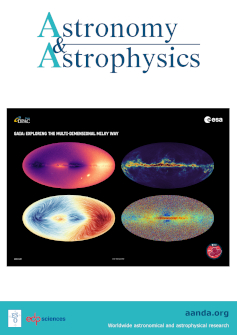UV photodissociation of H2+ in interstellar radiation fields: Shape resonances and astrophysical implications
IF 5.4
2区 物理与天体物理
Q1 ASTRONOMY & ASTROPHYSICS
引用次数: 0
Abstract
Aims. Prior investigations into the photodissociation dynamics of the hydrogen molecular ion (H2+) have frequently neglected the impact of shape resonances, which could potentially lead to inaccuracies in astrophysical modeling. This study systematically explores the photodissociation cross sections of H2+ with a rigorous consideration of shape resonances. We aim to elucidate comprehensively the photodissociation mechanisms by accurately accounting for transitions from the electronic ground state 12Σg+ to multiple electronically excited states. Our results provide updated, precise cross-sectional data essential for refining chemical evolution models of interstellar environments and for rectifying previous methodological oversights.Methods. We employed high-level ab initio calculations based on the multireference single- and double-excitation configuration interaction (MRDCI) method to determine the electronic structure of the H2+ ion accurately. The photodissociation cross sections were calculated under the assumption of local thermodynamic equilibrium (LTE) across photon wavelengths ranging from 25 nm to the dissociation threshold, incorporating contributions from the majority of rovibrational states of the ground electronic state. Particular attention was given to analyzing the effects of shape resonances, especially the significant role played by the 12Πu state near the spectral region of the Lyman α line.Results. Our computed cross sections clearly demonstrate that shape resonances substantially influence the photodissociation dynamics of H2+ near the Lyman α line. The contribution from the 12Πu excited state prominently shapes the spectral absorption features around the Lyman α region. These refined theoretical results offer substantial improvements over previous datasets, delivering the precise spectral information necessary for astrophysical simulations, modeling ultraviolet-driven chemical processes in interstellar media, and enhancing our understanding of photochemical dynamics in the early universe.星际辐射场中H2+的紫外光解:形状共振和天体物理意义
目标。先前对氢分子离子(H2+)光解动力学的研究经常忽略了形状共振的影响,这可能导致天体物理模型的不准确性。本研究系统地探讨了H2+的光解截面,并严格考虑了形状共振。我们的目标是通过精确地计算从电子基态12Σg+到多个电子激发态的转变来全面阐明光解机制。我们的结果提供了最新的、精确的横截面数据,这对于完善星际环境的化学演化模型和纠正以前的方法疏忽至关重要。我们采用基于多参考单激发和双激发组态相互作用(MRDCI)方法的高水平从头计算来精确确定H2+离子的电子结构。在光子波长从25 nm到解离阈值范围内的局部热力学平衡(LTE)假设下计算了光解截面,其中包含了基电子态的大多数旋转振动态的贡献。特别注意分析了形状共振的影响,特别是在莱曼α线光谱区域附近12Πu状态所起的重要作用。我们计算的横截面清楚地表明,形状共振实质上影响了Lyman α线附近H2+的光解动力学。12Πu激发态的贡献显著地决定了Lyman α区周围的光谱吸收特征。这些精细化的理论结果对以前的数据集提供了实质性的改进,提供了天体物理模拟所需的精确光谱信息,模拟了星际介质中紫外线驱动的化学过程,增强了我们对早期宇宙光化学动力学的理解。
本文章由计算机程序翻译,如有差异,请以英文原文为准。
求助全文
约1分钟内获得全文
求助全文
来源期刊

Astronomy & Astrophysics
地学天文-天文与天体物理
CiteScore
10.20
自引率
27.70%
发文量
2105
审稿时长
1-2 weeks
期刊介绍:
Astronomy & Astrophysics is an international Journal that publishes papers on all aspects of astronomy and astrophysics (theoretical, observational, and instrumental) independently of the techniques used to obtain the results.
 求助内容:
求助内容: 应助结果提醒方式:
应助结果提醒方式:


